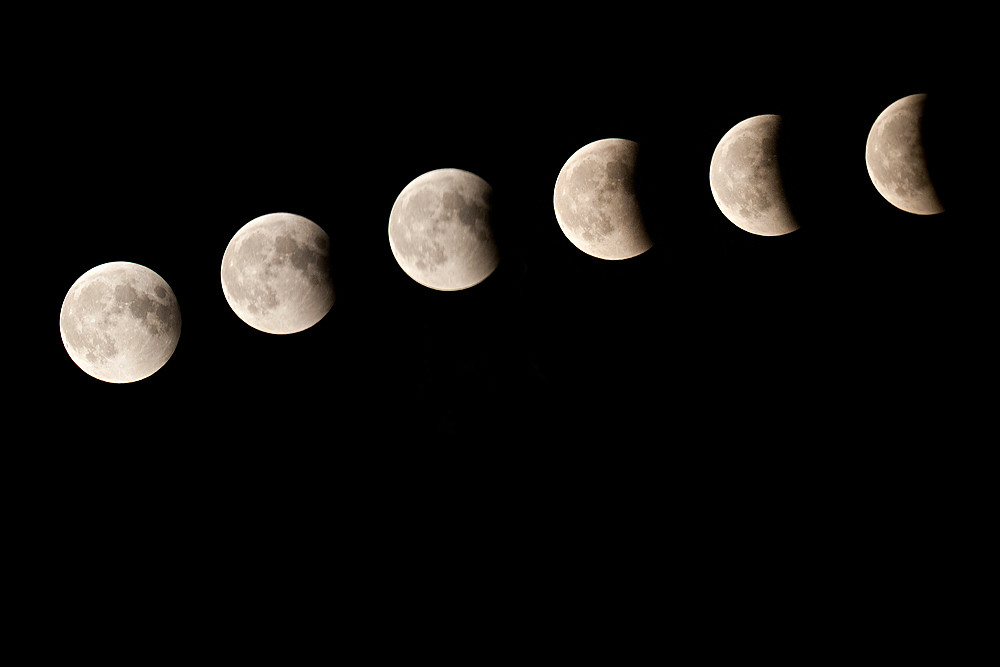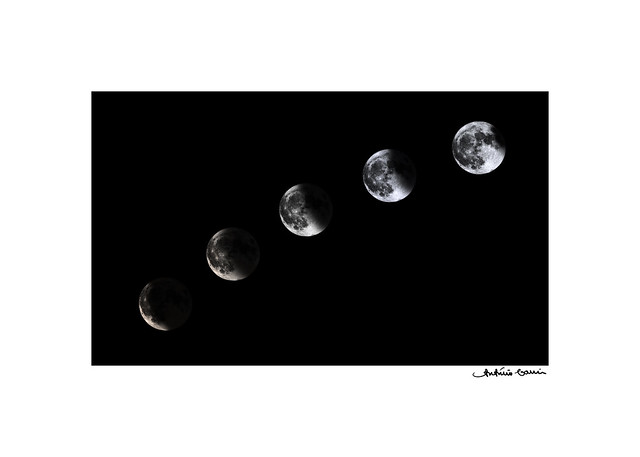 Helpful Posts: 0
Helpful Posts: 0
Results 1 to 20 of 24
Thread: Lunar Eclipse
-
15th June 2011, 10:56 PM #1
-
16th June 2011, 03:17 AM #2
Re: Lunar Eclipse
wow... it's like the photos in the calendar

tfs
-
16th June 2011, 03:23 AM #3
-
16th June 2011, 09:29 AM #4
Re: Lunar Eclipse
Nice try Jeroen. I was waiting for it but I fell asleep...thanks for sharing. It's beautiful

-
16th June 2011, 10:32 AM #5
Re: Lunar Eclipse
Great shot Jeroen. Sorry I missed it.
Cheers Dave
-
16th June 2011, 11:06 AM #6
Re: Lunar Eclipse
Thank you for the comments :-)
I really regret I couldn't get the entire cycle photographed.
-
16th June 2011, 12:14 PM #7
-
16th June 2011, 01:31 PM #8
Re: Lunar Eclipse
Thank you Frank,
These are individual captures combined in post processing. I could have done it in a single frame, but my tripod isn't stable enough for that.
The settings were varying a bit throughout the shoot because I was looking for the best settings andbecause the brightness of the moon was varying throughout the eclipse.
I started at f/5.6 and adjusted the ISO to get a decent shutter speed (shooting a subject at about 385000 km from your camera at 300mm on a wobbly tripod is a great source for camera shake on the shots) . My shutter speeds varied from 1/50s to 1/200s. Later on I switched to f/8.0 for sharper shots and aimed for a little lower ISO to get rid of some noise.
The biggest challenge was focusing correctly. The moon was too small and far away to get a proper auto-focus on it and manual focusing is very difficult because even the smallest twist on the focus ring makes a huge difference when shooting shooting at that distance.
It's a bit trial and error, but I hope it's useful to you.
-
16th June 2011, 01:54 PM #9rob marshall
Re: Lunar Eclipse
Lovely shot, Jeroen, and I can only admire your patience in taking it.
-
16th June 2011, 03:49 PM #10
Re: Lunar Eclipse
Excellent, thank you. I wonder if a Right Angle viewfinder with a 2X magnification might help with the focus? I was also thinking if you were using PP, would it be possible to keep the higher ISO and replace the black background with pure black? Or did the noise impact the Moon's surface as well?
-
16th June 2011, 04:16 PM #11
Re: Lunar Eclipse
Another option for focusing is to use live view if your camera has it, and often if it has live view, then it can be magnified in the live view as well... allowing you to often "zoom" in on your detail and fine tune your focus.
Also, when shooting the moon, you need to remember that you're shooting a moving subject. To get crisp shots, you need a shutterspeed of 1/100th or faster otherwise the movement will start to lose detail.
- Bill
-
16th June 2011, 04:31 PM #12
-
16th June 2011, 04:55 PM #13
Re: Lunar Eclipse
Live View doesn't *always* have a zoom feature, but it is becoming more and more prevalent. YMMV.
The 1/100 shutter speed is what is needed to combat the movement of the moon with respect to the camera (ie: multiple orbits and rotations happening). The 1/focal length "rule" is more of a handholding stability suggestion.
- Bill
-
16th June 2011, 06:22 PM #14
Re: Lunar Eclipse
Frank,
Since the moon is so much darker than it's surroundings, the area next to the sun in a photograph will about always come out plain black, even if it's dark blue to the eye. The noise is only visible on the moon surface. Removing it in PP is difficult because of the loose in detail on the moon's surface (which is already very hard to obtain wile focusing).
That 2* magnifier viewfinder sounds good. Do you have any experience with it?
Bill, thank you for mentioning the influence of the moon orbiting. I didn't calculated that.
-
16th June 2011, 06:36 PM #15
-
16th June 2011, 06:41 PM #16
Re: Lunar Eclipse - Setubal, portugal
Nice one Antonio!
I like the detail in yours, and also the vague show of the entire moon. Do you want to tell us some more about how you did it?
-
16th June 2011, 06:42 PM #17
-
16th June 2011, 08:52 PM #18

- Join Date
- Sep 2010
- Posts
- 2,064
Re: Lunar Eclipse - Setubal, portugal
Oh, good! Both of your moon eclipse shots are here together and I can tell you both, at the same time - impressive! I was watching the moon, last night, on a walk that I took too late in the evening. It got dark but the moon was rising and it had a golden/pinkish glow - reflected in the beaver pond with all of the fireflies sparkling. It was so beautiful and I was staring at it and so were you. It's a small world!!!

-
16th June 2011, 11:02 PM #19
Re: Lunar Eclipse
My practice was somehow similar. I kept my ISO and aperture all the time adjusting only the speed.
I started at 1/200s and ended at 1/400s with aperture at f/4.5 with ISO 200.
I was using a Canon 20D + 1.4 converter + 70-200mm f/2.8 L USM IS @ 200mm what means: 1.6 * 1.4 * 200 = 448 mm
I had no problem with focusing because to begin with I used the central point to focus and then switched it off taking care not to touch the focus ring.
My tripod is a very poor one. The final image is a careful composition of several shots.
My sequence is from the beginning of the phenomena while yours is in reverse, right ?
I also noticed that earlier - on the right in my picture - the light is warmer than later on. I played a bit with the filters to enhance that effect.
When I came home my wife and myself went outside and we could see that the sky was very clear and the Moon very bright. Absolutely no clouds or mist of any kind.
My wife even commented that the fields under the moonlight should be very nice due to the strength of the light.
I have once been in the country side under full moon just to shoot. It is not easy in Portugal as there is many houses everywhere and so, there is always much artificial light which is pernicious for long exposures of 30 seconds and more.
It may also be dangerous. Just standing in the middle of nowhere with no time to run away from someone whose intentions may not be the best is not the best way to shoot.
In another occasion I went with somebody else. In fact with 4 men and a woman. We had fun shooting in the dark.
We had fun shooting in the dark. 
Huumm a nice experience to try again some day with my small photography group
-
17th June 2011, 01:57 AM #20
Re: Lunar Eclipse
Hi Jeroen, Yes, I have the Nikon DR-6 Right Angle Viewer and used it to shoot the moon last month. Because the moon was such a small part of the image, it was still not ideal, just better. You might want to try one out before you buy as they are about $200 here in the US. I bought it because I sometimes take shots with the camera just inches off the ground and it is almost impossible to look through the viewfinder without one.
My Nikon D3100 does have the Live View Zoom that Bill was mentioning so I will try that next time I have a problem focusing.



 Reply With Quote
Reply With Quote

